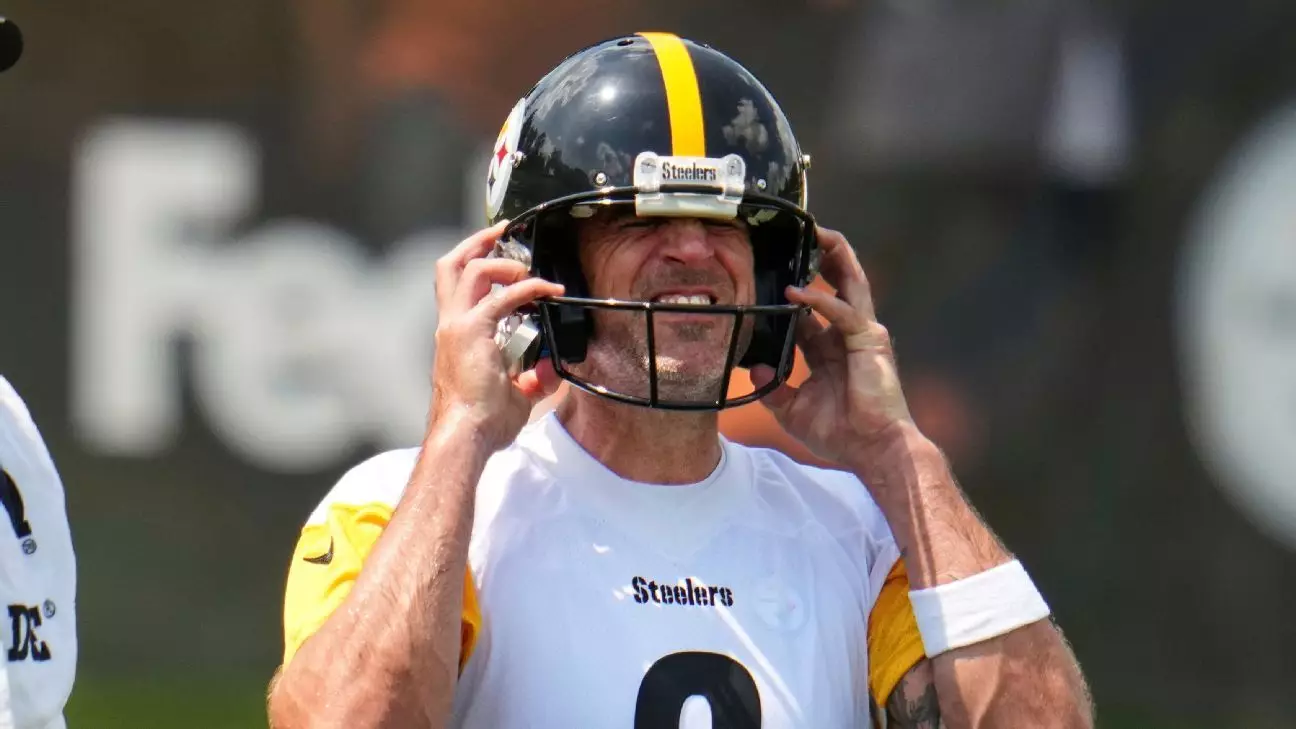In the relentless world of professional football, innovation often clashes with tradition. Nowhere is this more evident than in the seemingly minor but profoundly impactful issue of player safety gear. Aaron Rodgers, a seasoned veteran and new Steelers quarterback, finds himself in the midst of this paradigm shift — grappling with the transition to a new helmet model that his body and mind distrust. While safety standards evolve to protect athletes from catastrophic injuries, they inadvertently introduce new hurdles for players deeply accustomed to their gear. Rodgers’ outspoken dissatisfaction with the change reflects a broader tension in the sport: the struggle to balance cutting-edge safety innovations with the comfort and familiarity that players rely on for peak performance.
His vocal displeasure underscores a vital truth: trust in equipment isn’t merely about preference but about physical and psychological readiness. The helmet, a seemingly simple piece of equipment, becomes a symbol of the shifting landscape of football safety — one where progress demands adjustment, even when it feels counterintuitive. Rodgers’ analogy about the helmet looking like a “spaceship” emphasizes how technological advancements sometimes create their own psychological barriers. The fact that he’s willing to adapt, despite his reservations, signals a professional mindset that prioritizes safety over comfort, but it also highlights the emotional and mental toll these changes impose on athletes who pride themselves on consistency and familiarity.
Moreover, Rodgers’ experience is emblematic of a larger issue: the challenge of integrating evolving safety standards without alienating the very players they aim to protect. This tension is unlikely to ease in the foreseeable future, urging teams and equipment manufacturers to open channels for more player input. If innovation in sports safety feels imposed and impersonal, athletes’ compliance and comfort may be compromised, potentially influencing performance and mental resilience. Rodgers’ case isn’t an isolated incident but a call to action for the league to foster more collaborative approaches, ensuring safety upgrades bolster confidence without sacrificing the human element.
Injury and Resilience: The Unpredictable Nature of Football’s Physical Demands
While the helmet issue might seem minor compared to the physical toll of playing football, it serves as a stark reminder of the sport’s inherent brutality and the resilience required to persevere. Rodgers, returning from a recent Achilles tear, navigates the treacherous path back to peak form — already vulnerable, yet undeterred in pursuit of excellence. His brief scare during practice, when he was stepped on, exposes how quickly fortunes can change on the gridiron. Despite the pain and existing injuries, his ability to recover swiftly and return to practice again reveals an unwavering mental toughness that defines many successful players.
This incident also reflects the reality that football is unpredictable, and injuries are part of its fabric. Rodgers’ careful walking away from a contact play highlights the importance of resilience — not just physically but mentally. His experience demonstrates that even seasoned veterans must manage their bodies with meticulous attention, balancing aggressive play with caution, especially as age and past injuries loom large. His attitude suggests an understanding that setbacks are inevitable, but what differentiates champions is their capacity to adapt, recover, and maintain focus amid adversity.
Furthermore, the injury to rookie Will Howard adds another dimension to this narrative: the fragility of young prospects adjusting to the league’s high-stakes environment. The “freak accident” underscores the importance of developing not only physical skills but also mental fortitude. Howard’s willingness to accept his injury and focus on recovery exemplifies a growth mindset, crucial for long-term success in a sport that demands relentless perseverance.
The contrasting experiences of Rodgers and Howard deepen the conversation about resilience: seasoned players draw on experience to manage setbacks, while newcomers must develop mental toughness rapidly. The key takeaway is that football isn’t solely about physical prowess but about mental adaptability and emotional strength. The league’s focus should pivot towards fostering resilience at every level, recognizing that injuries, setbacks, and system changes are inevitable, but how players respond makes all the difference.
Leadership and Adaptation: The Invisible Force Driving a Team Forward
As Aaron Rodgers and Will Howard navigate their respective struggles, the role of leadership within the team emerges as a critical factor. Rodgers’ outspoken dissatisfaction with the helmet signifies not just personal frustration but a desire to uphold standards of professionalism and safety for himself and future teammates. His patience and willingness to adapt despite discomfort reflect an unwavering commitment to team success and safety, qualities that inspire confidence within the locker room.
Meanwhile, Howard’s resilience in the face of injury showcases potential leadership qualities of perseverance and positive attitude, even from the sidelines. His candidness about his injury and optimistic outlook set an example for peers, highlighting that setbacks can be opportunities to learn and grow. Both figures underscore a vital lesson: leadership extends beyond the field through attitude, adaptability, and a willingness to face adversity head-on.
The Steelers’ coaching staff and management also play pivotal roles in shaping this environment. Their response to player frustrations, their investment in safety innovation, and their fostered culture of resilience define not only the team’s present but its future. Supporting players through technical adjustments and injuries requires a nuanced understanding that leadership isn’t just about calling plays but about nurturing trust, confidence, and mental fortitude.
In the end, the Steelers’ ability to cultivate an environment where players feel supported, understood, and motivated to adapt despite challenges will determine their trajectory. Their leadership’s emphasis on resilience, safety, and innovation points toward a team committed to evolving both physically and mentally — a mindset necessary for sustained success in the fiercely competitive NFL.

